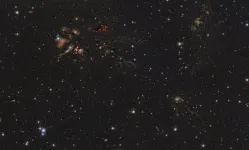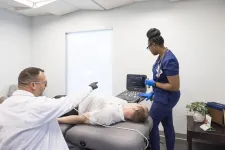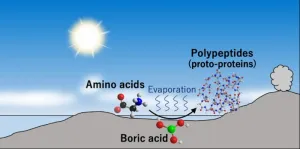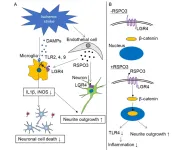(Press-News.org) Using ESO’s Visible and Infrared Survey Telescope for Astronomy (VISTA), astronomers have created a vast infrared atlas of five nearby stellar nurseries by piecing together more than one million images. These large mosaics reveal young stars in the making, embedded in thick clouds of dust. Thanks to these observations, astronomers have a unique tool with which to decipher the complex puzzle of stellar birth.
“In these images we can detect even the faintest sources of light, like stars far less massive than the Sun, revealing objects that no one has ever seen before,” says Stefan Meingast, an astronomer at the University of Vienna in Austria and lead author of the new study published today in Astronomy & Astrophysics. “This will allow us to understand the processes that transform gas and dust into stars.”
Stars form when clouds of gas and dust collapse under their own gravity, but the details of how this happens are not fully understood. How many stars are born out of a cloud? How massive are they? How many stars will also have planets?
To answer these questions, Meingast’s team surveyed five nearby star-forming regions with the VISTA telescope at ESO’s Paranal Observatory in Chile. Using VISTA’s infrared camera VIRCAM, the team captured light coming from deep inside the clouds of dust. “The dust obscures these young stars from our view, making them virtually invisible to our eyes. Only at infrared wavelengths can we look deep into these clouds, studying the stars in the making,” explains Alena Rottensteiner, a PhD student also at the University of Vienna and co-author of the study.
The survey, called VISIONS, observed star-forming regions in the constellations of Orion, Ophiuchus, Chamaeleon, Corona Australis and Lupus. These regions are less than 1500 light-years away and so large that they span a huge area in the sky. The diameter of VIRCAM’s field of view is as wide as three full Moons, which makes it uniquely suited to map these immensely big regions.
The team obtained more than one million images over a period of five years. The individual images were then pieced together into the large mosaics released here, revealing vast cosmic landscapes. These detailed panoramas feature dark patches of dust, glowing clouds, newly-born stars and the distant background stars of the Milky Way.
Since the same areas were observed repeatedly, the VISIONS data will also allow astronomers to study how young stars move. “With VISIONS we monitor these baby stars over several years, allowing us to measure their motion and learn how they leave their parent clouds,” explains João Alves, an astronomer at the University of Vienna and Principal Investigator of VISIONS. This is not an easy feat, as the apparent shift of these stars as seen from Earth is as small as the width of a human hair seen from 10 kilometres away. These measurements of stellar motions complement those obtained by the European Space Agency’s Gaia mission at visible wavelengths, where young stars are hidden by thick veils of dust.
The VISIONS atlas will keep astronomers busy for years to come. “There is tremendous long-lasting value for the astronomical community here, which is why ESO steers Public Surveys like VISIONS,” says Monika Petr-Gotzens, an astronomer at ESO in Garching, Germany, and co-author of this study. Moreover, VISIONS will set the groundwork for future observations with other telescopes such as ESO’s Extremely Large Telescope (ELT), currently under construction in Chile and set to start operating later this decade. “The ELT will allow us to zoom into specific regions with unprecedented detail, giving us a never-seen-before close-up view of individual stars that are currently forming there,” concludes Meingast.
More information
This research was presented in the paper “VISIONS: The VISTA Star Formation Atlas”, to appear in Astronomy & Astrophysics (doi: 10.1051/0004-6361/202245771)
The team is composed of Stefan Meingast (University of Vienna, Austria [Vienna]), João Alves (Vienna), Hervé Bouy (Université de Bordeaux, France [Bordeaux]), Monika G. Petr-Gotzens (European Southern Observatory, Germany [ESO]), Verena Fürnkranz (Max-Planck-Institut für Astronomie, Germany [MPIA]]), Josefa E. Großschedl (Vienna), David Hernandez (Vienna), Alena Rottensteiner (Vienna), Joana Ascenso (Universidade do Porto, Portugal [Porto]; Universidade de Lisboa, Portugal [Lisboa]), Amelia Bayo (ESO; Universidad de Valparaíso, Chile), Erik Brändli (Vienna), Anthony G. A. Brown (Leiden University, Netherlands), Jan Forbrich (University of Hertfordshire, UK [Hertfordshire]), Alyssa Goodman (Harvard-Smithsonian Center for Astrophysics, USA [CfA]), Alvaro Hacar (Vienna), Birgit Hasenberger (Vienna), Rainer Köhler (The CHARA Array of Georgia State University, USA), Karolina Kubiak (Lisboa), Michael Kuhn (Hertfordshire), Charles Lada (CfA), Kieran Leschinski (Vienna), Marco Lombardi (Università degli Studi di Milano, Italy), Diego Mardones (Universidad de Chile, Chile), Núria Miret-Roig (European Space Agency, European Space Research and Technology Centre, Netherlands [ESA]), André Moitinho (Lisboa), Koraljka Mužiiić (Porto; Lisboa), Martin Piecka (Vienna), Laura Posch (Vienna), Timo Prusti (ESA), Karla Peña Ramírez (Universidad de Antofagasta, Chile), Ronny Ramlau (Johannes Kepler University Linz, Austria; Johann Radon Institute for Computational and Applied Mathematics, Austria), Sebastian Ratzenböck (Vienna; Research Network Data Science at Uni Vienna), Germano Sacco (INAF – Osservatorio Astrofisico di Arcetri, Italy), Cameren Swiggum (Vienna), Paula Stella Teixeira (University of St Andrews, UK), Vanessa Urban (Vienna), Eleonora Zari (MPIA), and Catherine Zucker (Bordeaux).
The European Southern Observatory (ESO) enables scientists worldwide to discover the secrets of the Universe for the benefit of all. We design, build and operate world-class observatories on the ground — which astronomers use to tackle exciting questions and spread the fascination of astronomy — and promote international collaboration in astronomy. Established as an intergovernmental organisation in 1962, today ESO is supported by 16 Member States (Austria, Belgium, the Czech Republic, Denmark, France, Finland, Germany, Ireland, Italy, the Netherlands, Poland, Portugal, Spain, Sweden, Switzerland and the United Kingdom), along with the host state of Chile and with Australia as a Strategic Partner. ESO’s headquarters and its visitor centre and planetarium, the ESO Supernova, are located close to Munich in Germany, while the Chilean Atacama Desert, a marvellous place with unique conditions to observe the sky, hosts our telescopes. ESO operates three observing sites: La Silla, Paranal and Chajnantor. At Paranal, ESO operates the Very Large Telescope and its Very Large Telescope Interferometer, as well as survey telescopes such as VISTA. Also at Paranal ESO will host and operate the Cherenkov Telescope Array South, the world’s largest and most sensitive gamma-ray observatory. Together with international partners, ESO operates ALMA on Chajnantor, a facility that observes the skies in the millimetre and submillimetre range. At Cerro Armazones, near Paranal, we are building “the world’s biggest eye on the sky” — ESO’s Extremely Large Telescope. From our offices in Santiago, Chile we support our operations in the country and engage with Chilean partners and society.
Links
Research paper
Photos of VISTA
For journalists: subscribe to receive our releases under embargo in your language
For scientists: got a story? Pitch your research
Contacts
Stefan Meingast
University of Vienna
Vienna, Austria
Email: stefan.meingast@univie.ac.at
Juan Carlos Muñoz Mateos
ESO Media Officer
Garching bei München, Germany
Tel: +49 89 3200 6176
Email: press@eso.org
END
ESO telescope reveals hidden views of vast stellar nurseries
2023-05-11
ELSE PRESS RELEASES FROM THIS DATE:
Majority of nurses attribute well-being struggles to staffing shortages
2023-05-11
Cross Country Healthcare, Inc. (NASDAQ: CCRN), a market-leading, tech-enabled workforce solutions platform and advisory firm, in collaboration with Florida Atlantic University, today announced the results of its annual survey of nursing professionals and students.
The study found that although nurses are passionate about doing meaningful work and earning a good income, only one-third of nurses plan to remain in the profession for the foreseeable future, and about one-fourth plan to leave in just one to two years from now. The survey, conducted in collaboration with FAU’s Christine E. Lynn College of Nursing, found ...
Researchers uncover how primordial proteins formed on prebiotic earth
2023-05-11
How did catalytic organic polymers emerge on prebiotic Earth? Answering this essential question will unlock key understandings in the origin of life.
A team of scientists at Tohoku University have recently found a potential environment for the reaction that produced catalytic organic polymers. To do so, they dried down amino acid solutions containing boric acid and found that boric acid catalyzes polypeptide synthesis under neutral and acidic conditions. The longest peptides formed in the experiments were 39 monomer-long glycine polypeptides under a neutral condition.
Previous studies ...
Women with hardened arteries may need stronger treatment to prevent heart attacks than men
2023-05-11
Barcelona, Spain – 11 May 2023: Postmenopausal women with clogged arteries are at higher risk of heart attacks than men of similar age, according to research presented at EACVI 2023, a scientific congress of the European Society of Cardiology (ESC),1 and published in European Heart Journal - Cardiovascular Imaging.2 The study in nearly 25,000 adults used imaging techniques to examine the arteries and followed patients for heart attacks and death.
“The study suggests that a given burden of atherosclerosis ...
A potential pathway to improved stroke recovery
2023-05-11
Osaka, Japan – Ischemic stroke, caused by a blockage of blood flow to the brain, is a common cause of death and disability. Treatments are urgently needed to improve patient outcomes, because recovery currently depends largely on the timely injection of a blood clot-dissolving drug. Priorities for therapy include limiting inflammation at the ischemic site and rebuilding neuronal connections damaged by the stroke. However, a molecule that can achieve these therapeutic effects has remained elusive.
In a study to be published in Stroke, researchers from Osaka University provide new hope for patients. They have identified ...
Hidden supermassive black holes brought to life by galaxies on collision course
2023-05-11
Astronomers have found that supermassive black holes obscured by dust are more likely to grow and release tremendous amounts of energy when they are inside galaxies that are expected to collide with a neighbouring galaxy. The new work, led by researchers from Newcastle University, is published in Monthly Notices of the Royal Astronomical Society.
Galaxies, including our own Milky Way, contain supermassive black holes at their centres. They have masses equivalent to millions, or even billions, times that of our ...
Rooftop solar panels could power one third of US manufacturing sector
2023-05-11
Rooftop solar arrays have the potential to meet the annual electricity demands of up to 35% of US manufacturing sectors.
On-site sources of renewable energy currently supply less than 0.1% of industrial electricity demand in the US.
The industrial sector accounts for 38% of global energy consumption and 37% of greenhouse gas emissions.
Despite having the potential to cover 13.6% of the national electricity demand, rooftop solar arrays currently account for just 2.2% of the electricity grid mix.
Mounted on the rooftops ...
Students positive towards AI, but uncertain about what counts as cheating
2023-05-11
Students in Sweden are positive towards AI tools such as ChatGPT in education, but 62 percent believe that using chatbots during exams is cheating. However, where the boundary for cheating lies is highly unclear. This is shown in a survey from Chalmers University of Technology, which is the first large-scale study in Europe to investigate students' attitudes towards artificial intelligence in higher education.
“I am afraid of AI and what it could mean for the future.”
“Don't worry so much! Keep up with the development and adapt your teaching ...
Health worker shortages strongly linked to excess deaths
2023-05-11
Shortages of health workers such as doctors, nurses and midwifery staff are strongly associated with higher death rates, especially for certain diseases such as neglected tropical diseases and malaria, pregnancy and birth complications, diabetes and kidney diseases, finds an analysis of 172 countries and territories, published by The BMJ today.
The results show that, although inequalities in health workforces have been decreasing globally over the past 30 years, they continue to have a substantial ...
Experts call for monitoring of respiratory vaccine after trials suggest possible increase in preterm births
2023-05-11
Experts have called for further scrutiny of a new Pfizer vaccine given during pregnancy to prevent respiratory infection in infants, after trials of a similar GSK vaccine were stopped after a rise in preterm birth and infant deaths.
Pfizer says its vaccine is safe and effective, but experts contacted as part of an investigation published by The BMJ today, say Pfizer’s trial data should be reviewed in light of the signal for preterm births seen in GSK’s trial.
Pfizer’s ...
Jellybeans – a sweet solution for overcrowded circuitry in quantum computer chips
2023-05-11
The silicon microchips of future quantum computers will be packed with millions, if not billions of qubits – the basic units of quantum information – to solve the greatest problems facing humanity. And with millions of qubits needing millions of wires in the microchip circuitry, it was always going to get cramped in there.
But now engineers at UNSW Sydney have made an important step towards solving a long-standing problem about giving their qubits more breathing space -- and it all revolves around jellybeans.
Not the kind we rely on for a sugar hit to get us past the 3pm slump. But jellybean quantum dots –elongated areas between qubit ...






